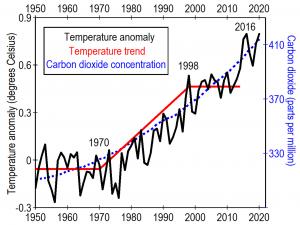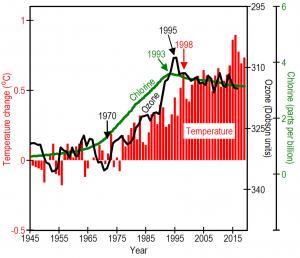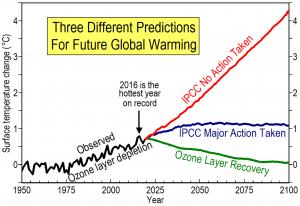
NOAA Declares 2020 the Second Hottest Year on Record, a Very Close Second

Carbon dioxide concentrations (dashed blue line) have increased steadily while annual average temperature anomalies (black line) changed very little from 1950 to 1970 and from 1998 to 2014 (red line).
This observation documents global warming but suggests that increases in greenhouse-gas emissions may not be the best explanation
“What is surprising,” according to Ward, “is that greenhouse-warming theory cannot explain these sudden changes in global temperature without a great deal of arm waving. Furthermore, no scientist has ever shown in the laboratory that increases in greenhouse-gas concentrations can actually cause warming of Earth’s surface.”
Concentrations of greenhouse gases in the atmosphere have increased every year since 1950 at ever-increasing rates. Average global surface temperatures, on the other hand, have changed much more irregularly.
All four major analyses of global temperatures by NASA, NOAA, the United Kingdom’s Met Office, and Berkeley Earth show that temperatures remained relatively constant from 1950 to 1970, rose suddenly from 1970 to 1998, remained relatively constant from 1998 to 2014, rose very rapidly from 2014 to 2016, decreased substantially in 2018 but rose again in 2019 and 2020. Each of these sudden changes in temperature correlates quite closely with sudden changes in the thickness of the ozone layer.
The ozone layer, 9 to 22 miles above Earth, absorbs nearly all ultraviolet-B (UV-B) radiation from Sun, protecting life on Earth from this high-energy radiation that causes sunburn, skin cancer, cataracts, and mutations.
“What is critically important,” Ward explains, “is that when a molecule of ozone absorbs ultraviolet-B radiation, the molecule is dissociated—it comes apart. The molecular pieces fly away from each other at high velocity, much like the ends of a snapped rubber band. Dissociation converts molecular bond energy holding the molecule together directly and completely into linear velocity, which is directly proportional to air temperature, warming the ozone layer. The molecular pieces can then recombine, so that dissociation will continue as long as UV-B radiation is available.”
A depleted ozone layer absorbs less UV-B, growing cooler as observed. More UV-B is then measured to reach Earth where it dissociates ground level ozone pollution, warming Earth’s surface. Warming since 1970 was nearly twice as much in the northern hemisphere, home to 90% of humanity and, therefore, home to most ground-level ozone pollution. Warming since 1970 was greatest on the Antarctic Peninsula, where ozone depletion was greatest.
UV-B radiation penetrates oceans more than a hundred feet, raising ocean heat content very efficiently since 1970, an observation that greenhouse-warming theory cannot explain.
Around 1970, ozone depletion began to increase especially above Antarctica, forming the Antarctic ozone hole in mid to late winter. The greatest depletion of ozone over Antarctica occurred in 1998.
During the 1960s, chemical companies manufactured chlorofluorocarbon gases (CFCs) for use as spray-can propellants, refrigerants, foam-blowing agents, and solvents. CFCs were safer to use than alternatives because they were unusually inert.
In 1974, scientists discovered that CFCs in the stratosphere can be broken down by solar ultraviolet radiation, releasing atoms of chlorine. One atom of chlorine can destroy 100,000 molecules of ozone. Their work earned earned the Nobel Prize in Chemistry in 1995.
In 1985, with discovery of the Antarctic ozone hole, scientists and political leaders moved quickly to pass the United Nations Montreal Protocol on Substances that Deplete the Ozone Layer, which took effect in 1989, severely limiting manufacturing of CFCs. By 1993, concentrations of CFCs in the atmosphere stopped increasing. By 1995, global average ozone depletion stopped increasing. By 1998, global average temperatures stopped increasing.
Humans had caused global warming beginning around 1970 by manufacturing CFCs. Humans had stopped the increase in global warming by passing the Montreal Protocol.
In 2014, the volcano Bárðarbunga in central Iceland began erupting basaltic lava flows, covering an area of 33 square miles within six months, the largest basaltic eruption since 1784. Average global temperatures began rising at five-times the rate observed between 1970 and 1998, reaching a maximum in 2016.
Temperatures increased by volcanic eruptions normally recover within a few years. Temperatures cooled until 2018 when Kilauea volcano in Hawaii erupted basaltic lava flows from the lower East Rift. These lava flows were much more extensive than typical in Hawaii, covering 39 square miles of land in three months. The rate of lava extrusion was nearly the same as for Bárðarbunga, but the eruption lasted half as long. Average global temperatures began rising again, causing 2020 to be nearly as warm as 2016.
Basaltic lavas contain exceptionally large amounts of chlorine and bromine gases. It only takes a small amount of these gases to reach the lower stratosphere to deplete the ozone layer. Ozone depletion is observed following most volcanic eruptions, peaking two years after the eruption stops.
Explosive volcanic eruptions cause ozone depletion but also eject water vapor and sulfur dioxide into the lower stratosphere forming an aerosol or mist that reflects and disperses sunlight, causing net global cooling for two to four years. Climate is warmed by basaltic lava flows and cooled by explosive eruptions.
Throughout Earth history, major, sudden global warming is contemporaneous with major basaltic lava flows—the larger the flow, the greater the warming.
It is the Bárðarbunga eruption in Iceland in 2014 that appears to have caused 2016 to be the hottest year on record. It was the Kilauea eruption in Hawaii during 2018 that appears to have caused 2020 to be nearly as hot.
If ozone depletion is the major cause of global warming, global temperatures are expected to decrease slowly throughout this century. Major warming predicted by computer climate models based on greenhouse-warming theory will not and cannot occur.
“Don’t you think my fellow scientists need to look at these very clear data carefully before we waste tens of trillions of dollars trying to reduce greenhouse-gas emissions?”
More information is available at WhyClimateChanges.com.
Peter L. Ward
Science Is Never Settled
+1 307-413-4055
email us here
Visit us on social media:
Facebook
Twitter
LinkedIn
How the atmosphere is warmed. A talk presented at the annual meeting of the American Meteorological Society on January 12, 2021.
Distribution channels: Agriculture, Farming & Forestry Industry, Automotive Industry, Aviation & Aerospace Industry, Business & Economy, Chemical Industry, Education, Energy Industry, Environment, International Organizations, Natural Disasters ...
Legal Disclaimer:
EIN Presswire provides this news content "as is" without warranty of any kind. We do not accept any responsibility or liability for the accuracy, content, images, videos, licenses, completeness, legality, or reliability of the information contained in this article. If you have any complaints or copyright issues related to this article, kindly contact the author above.
Submit your press release

